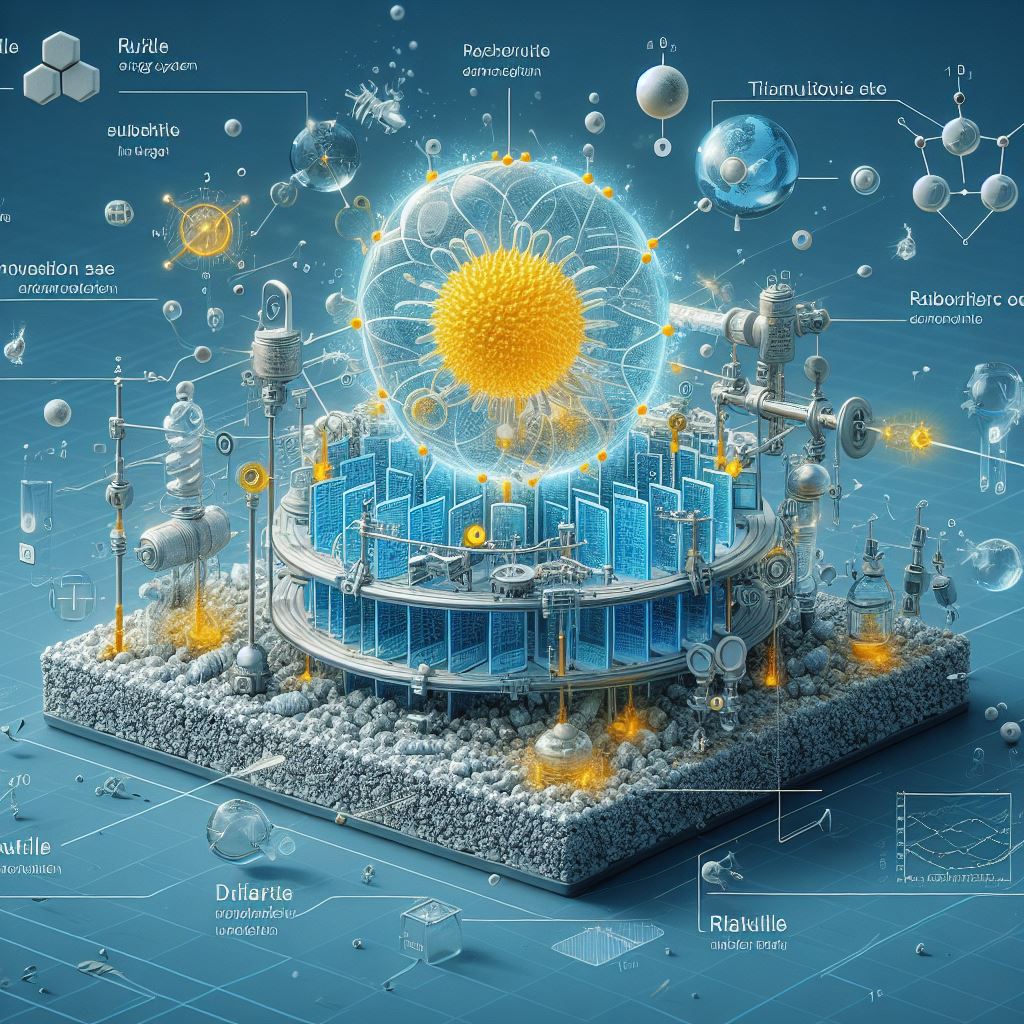Introduction – Rutile
Rutile technology, a subset of materials engineering, has seen remarkable advancements in recent years, unlocking new possibilities across various industries. This blog post aims to provide a comprehensive overview of Rutile’s technology. Its significance, current state, breakthroughs, benefits, challenges, and prospects. We will also delve into historical aspects, key players, environmental impact, and economic implications. Real-world applications, maintain a friendly and jargon-free tone throughout.
Rutile Technology: A Brief Overview
Historical Background and Evolution
Rutile, a naturally occurring mineral primarily composed of titanium dioxide, has a rich history in industrial applications. Historically, rutile found use in pigments, ceramics, and even early attempts at producing metallic titanium. However, it’s in recent decades that advances in materials engineering have uncovered new dimensions of this versatile substance.
The evolution of Rutile’s technology has been marked by a series of breakthroughs. Each expands its potential applications and enhances its properties. Researchers and engineers have continuously explored ways to leverage rutile’s unique characteristics. Leading to the development of innovative solutions across diverse industries.
Significance in Various Industries
Rutile’s significance lies in its exceptional properties, including high refractive index, chemical stability, and corrosion resistance. These attributes make rutile a sought-after material in industries such as:
- Pigments and Coatings: Rutile is widely used as a white pigment in paints, plastics, and coatings due to its brightness and opacity.
- Electronics and Optics: Its high refractive index makes rutile valuable in optical devices and electronics, contributing to the production of lenses, prisms, and high-quality glass.
- Catalysis and Photocatalysis: Rutile’s photocatalytic properties have applications in environmental purification and catalysis, playing a role in wastewater treatment and air purification.
- Energy Storage: Rutile-based materials are being explored for use in advanced energy storage devices, such as batteries and capacitors, owing to their unique electronic properties.
Current State of Rutile Technology
While rutile has found success in various industries, there are limitations that researchers have been actively addressing. One challenge lies in the efficient extraction and processing of rutile, as traditional methods can be energy-intensive and environmentally impactful. Additionally, the scalability of certain rutile-based technologies for large-scale commercial use remains a hurdle.
Recent Breakthroughs in Rutile Technology

Advanced Extraction Techniques
Recent breakthroughs in rutile extraction techniques have focused on improving efficiency and reducing environmental impact. Innovations in sustainable mining practices and ore processing have not only increased the yield of high-quality rutile but also minimized the ecological footprint associated with its extraction.
Enhanced Photocatalytic Properties
In the realm of environmental applications, researchers have made strides in enhancing rutile’s photocatalytic properties. This has led to more efficient and selective degradation of pollutants in air and water, offering promising solutions for environmental remediation.
Rutile-Based Energy Storage
The exploration of rutile-based materials in energy storage devices has yielded exciting results. Researchers have developed novel electrode materials using rutile, showcasing improved energy density and cycling stability in batteries. This breakthrough opens avenues for the development of next-generation energy storage solutions.
Benefits and Potential Applications – Rutile
Improved Efficiency and Performance
The recent advancements in Rutile’s technology translate to improved efficiency and performance across various applications. In the electronics and optics industry, for example, the use of high-quality rutile contributes to the production of clearer lenses and more efficient optical devices.
Environmental Benefits
The enhanced photocatalytic properties of rutile offer environmentally friendly solutions for pollution control. Rutile-based catalysts in wastewater treatment and air purification can accelerate the degradation of contaminants, contributing to cleaner ecosystems.
Energy Storage Solutions
In the realm of energy storage, rutile-based materials show promise in addressing the growing demand for efficient and sustainable battery technologies. This could have far-reaching implications for electric vehicles, portable electronics, and grid energy storage.
Comparison with Existing Technologies
When compared to existing technologies, the recent breakthroughs in Rutile’s technology showcase competitive advantages. In terms of photocatalysis, rutile has demonstrated superior efficiency in pollutant degradation compared to traditional catalysts. In energy storage, rutile-based electrodes exhibit enhanced performance metrics, positioning them as strong contenders in the evolving landscape of battery technologies.
Challenges and Future Considerations – Rutile
Scalability and Commercialization
One of the primary challenges in Rutile’s technology is scaling up these advancements for commercial use. While breakthroughs in extraction and processing have been achieved at the laboratory scale, transitioning to large-scale industrial applications requires addressing logistical and economic considerations. Researchers are actively working on optimizing production processes to ensure scalability without compromising efficiency.
Cost Considerations
The economic viability of rutile-based technologies remains a key consideration. While the long-term benefits in terms of performance and sustainability are evident, initial costs associated with extraction, processing, and manufacturing may pose challenges. Striking a balance between cost-effectiveness and long-term sustainability will be crucial for widespread adoption.
Environmental Impact and Sustainability
As with any industrial process, the environmental impact of rutile extraction and processing must be carefully managed. Sustainable mining practices, coupled with eco-friendly processing techniques, are imperative to ensure that the benefits of rutile technology do not come at the expense of environmental degradation. Researchers and industry stakeholders are actively exploring ways to minimize the ecological footprint of rutile-related activities.
Future Prospects and Developments
The future of Rutile’s technology looks promising, with ongoing research poised to unlock new applications and refine existing processes. Collaborations between academia, industry, and government entities are crucial for driving innovation in this field. Potential developments include:
- Advanced Materials: Continued research may lead to the development of advanced rutile-based materials with tailored properties, opening up new possibilities in fields like electronics, aerospace, and healthcare.
- Green Processing Techniques: Researchers are exploring greener and more sustainable processing techniques for rutile extraction and refinement, aligning with global initiatives for environmentally conscious practices.
- Global Partnerships: International collaborations may accelerate the development and adoption of Rutile’s technology, fostering a global community dedicated to harnessing the potential of this versatile material.
Key Players and Organizations
Several key players and organizations contribute significantly to the research and development of Rutile’s technology. Notable entities include academic institutions conducting cutting-edge research, industrial partners exploring commercial applications, and governmental agencies supporting initiatives in materials engineering. Collaboration among these stakeholders is vital for driving innovation and ensuring the successful integration of Rutile’s technology into various industries.
Environmental Impact and Sustainability
The environmental impact of Rutile’s technology cannot be ignored, and efforts are underway to address this aspect responsibly. Sustainable mining practices, efficient processing techniques, and recycling initiatives are essential components of a holistic approach to mitigate the environmental footprint associated with rutile extraction and utilization.
Economic Implications and Market Opportunities
The economic implications of Rutile’s technology are multifaceted. While initial investments may be significant, the long-term benefits in terms of improved product performance, reduced environmental impact, and diversified market opportunities are compelling. Rutile-based technologies have the potential to carve out a niche in markets ranging from electronics and energy storage to environmental remediation, presenting a unique value proposition for investors and industries alike.
Real-World Applications and Case Studies
Several real-world applications showcase the practicality of Rutile’s technology. In the field of wastewater treatment, rutile-based photocatalysts have been successfully employed to degrade pollutants, providing a cost-effective and sustainable solution. Similarly, the use of rutile in high-performance optics has led to the development of clearer and more durable lenses, benefiting consumers in industries such as photography and eyewear.
Follow-Up Questions
- Differences from Other Materials Engineering Technologies: Rutile’s technology differs from other materials engineering technologies in its unique combination of properties, including high refractive index, chemical stability, and photocatalytic capabilities. These set it apart in applications ranging from pigments to energy storage.
- Industries Expected to Benefit the Most: Industries such as electronics, optics, energy storage, and environmental remediation are poised to benefit significantly from Rutile’s technology breakthroughs. The versatile nature of rutile opens doors for applications in various sectors.
- Challenges in Scaling Up for Commercial Use: The primary challenge in scaling up Rutile’s technology lies in optimizing extraction, processing, and manufacturing processes to meet the demands of large-scale commercial applications. Logistical, economic, and environmental considerations must be addressed for successful scaling.
- Environmental Benefits of Rutile’s Technology: Rutile’s technology offers environmental benefits, particularly in photocatalysis for pollution control. By accelerating the degradation of contaminants, rutile contributes to cleaner air and water, aligning with sustainability goals.
- Ongoing Research Projects or Collaborations: Ongoing research projects and collaborations are essential for advancing Rutile’s technology. Close partnerships between academia, industry, and government entities drive innovation and accelerate the development of new applications.
Conclusion
In conclusion, recent Rutile’s technology breakthroughs represent an exciting chapter in materials engineering. From historical roots to current applications and prospects, rutile’s journey showcases the dynamic nature of scientific discovery and innovation. As researchers push the boundaries of what’s possible with rutile, the potential for transformative impacts on industries and the environment becomes increasingly apparent. Addressing challenges, fostering collaborations, and embracing sustainable practices, rutile’s technology stands poised to positively shape the future of materials engineering.
Zinc Oxide: The Remarkable Addition To Your Skincare Routine








Pingback: Titanium Element: A Unique And Powerful Insider's Perspective - Safe Climber Overseas Pvt. Ltd.